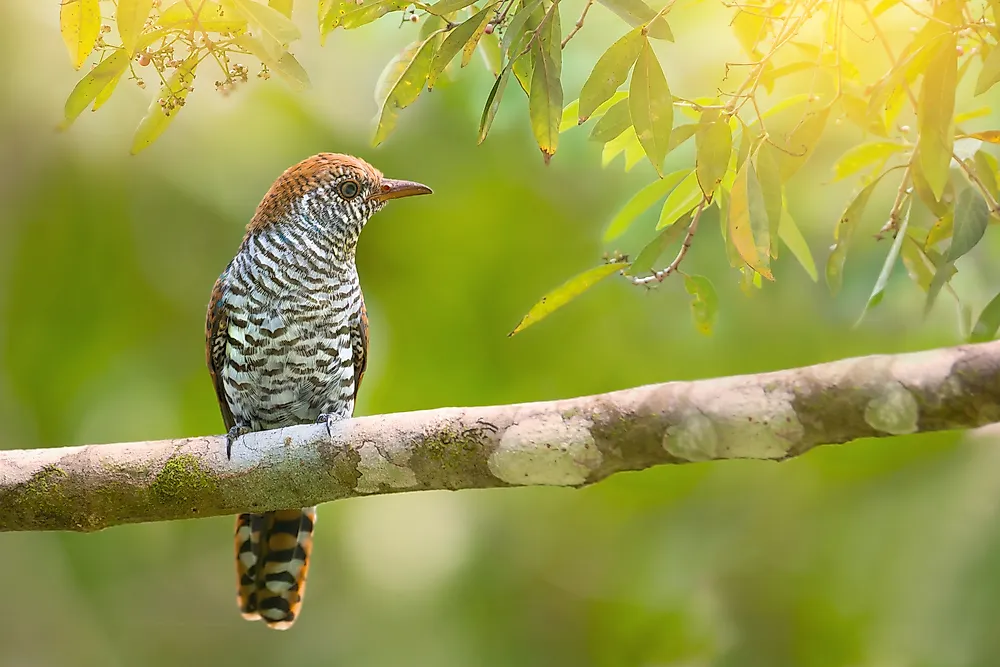Cuckoo Birds - Animals of the World

Cuckoos are a family of birds that encompass approximately 127 species around the globe. Cuckoos are found on all continents except Antartica, and live in a diverse range of habitats. Some species are arboreal, while others are terrestrial. Many are insectivores, although some are known to consume lizards and other birds when available.
Physical Description
Cuckoo birds and medium-sized birds ranging from 0.03 pounds to 1.4 pounds while their length ranges from 6 to 25 inches. The channel-billed cuckoo is the largest species. The feet of cuckoos are characterized by four toes with the two inner toes pointing forward while the two outer toes point backwards.
While several species, including the Common Cuckoo (Cuculus canorus) are grey-brown, various species of cuckoos exhibit colorful feather patterns. The Violet cuckoo (Chrysococcyx xanthorhynchus) has a violet chin and breast with violet or green bars on a white belly. The Asian emerald cuckoo (Chrysococcyx maculatus) has a green head and back with a green-barred white belly while the African emerald cuckoo (Chrysococcyx cupreus) has a green head and back with a bright yellow belly.
Some species like the common cuckoos can fly while others like the roadrunners are terrestrial. Both kinds of species have long tails with soft feathers that are used for steering during motion. Cuckoos that can fly have specialized wings that are capable of strong flight while terrestrial ones have short wings that are almost round. Despite several differences between species, the typical shape of cuckoos is marked by long wings, short legs, long tails and arboreal lives.
Habitat and Range
Cuckoo birds have a wide range in all the continents except Antarctica. Other parts they are absent include southwestern parts of South America, northern portions of North America, and dry parts of North Africa and the Middle East.
Cuckoos prefer a habitat full of food while parasitic breeders would go to a region with plenty of hosts. The habitats that are mostly preferred by the birds are forests and woodlands.
Behavior
For the most part, cuckoo birds are solitary with rare sightings as groups or pairs. Further, the birds are shy, and it is very difficult to see one. However, the anis are an exception to both of these behaviors. The anis are found in the Americas are full of social behaviors and are easier to spot.
Cuckoo birds have an extensive range of calls that serve different purposes from mating to declaring a territory. Also, some species can fly while others are flightless and are specialized for life on the ground.
Diet
Most cuckoo bird species are insectivorous. Cuckoo birds specialize in feeding on large insects and caterpillars that are usually avoided by other bird species. After catching the prey with their beaks, they squish it back and forth on hard objects then use specialized bony plates in the mouth to crush the food before swallowing.
Some species are specialized for catching and eating lizards, snakes, other birds, and small rodents. Other species eat fruit is it happens that they are raised by hosts that eat fruit.
Reproduction
The reproduction aspect of the cuckoo birds is very interesting. Despite popular belief about them, most species of the cuckoo bird make their own nests and take care of their young ones such as the malkohas. Most species lay their eggs alone while a few species lay eggs communally, like the anis, in nests built by all the group members who also share responsibilities. This group system may lead to conflict as other females may remove the eggs of others.
Few species are brood parasites. These species lay their eggs in the nests of other birds and leave all parenting to the host bird. Some species lay their eggs in nests of birds of a different species while others lay eggs in the nests of other cuckoo birds. Their eggs hatch early and remove the eggs of the hosts all the while tricking the host mother bird into caring for them.











